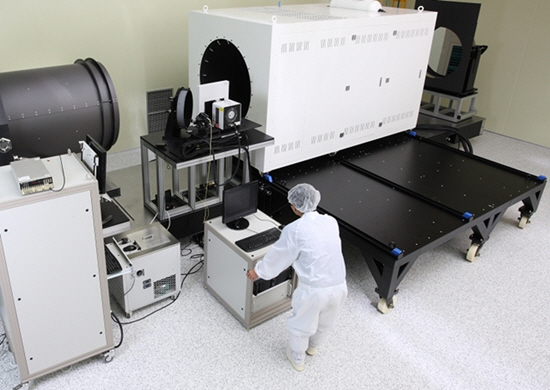Korean scientists develop technology for verifying infrared ray cameras
성수 최 2009-12-03 View. 15,235Korea Research Institute of Standards and Science develops evaluation device for large-sized infrared ray cameras to use device in Giant Magellan Telescope project An image of the evaluation device for infrared ray cameras.

(Photo) An image of the evaluation device for infrared ray cameras using a performance measurement system.
A Korean research team has developed a device that allows for the accurate assessment of large-sized infrared ray cameras, making Korea the third country in the world after the U.S. and Russia to develop the technology.
The research team, led by Yang Ho-soon of the Center for Space Optics(Head Lee Yun-woo) at the Korea Research Institute of Standards and Science(President Kim Myung-soo), said on November 12 it had developed a device for evaluating the performance of large-sized infrared ray cameras in partnership with Korean research institutes and industry.
The new device is capable of assessing whether an infrared ray optical system of up to 800mm in diameter can grade temperatures below the 0.01 degree Celsius level.

(Photo) Dr. Yang Ho-soon, a research scientist at the Center for Space Optics.
The evaluation device consists of an object section, which can adjust temperatures, and a "collimate device of 1meter in diameter" that renders the object to look as if it is far away by converting infrared rays emitted from the object section into parallel light rays, and software that operates the entire system and analyzes results of the measurement.
Collimate devices generally use off-axis parabolic surfaces, which generate parallel light. Notably, in order to assess the performance of an infrared ray camera that uses a large reflector measuring hundreds of mm in diameters, a collimate device that is larger and better in performance than the infrared ray camera to be assessed is essential. Advanced countries are restricting the export of large collimate devices since they can be used for military purposes.
Dr. Yang's team produced the device by changing the off-axis parabolic surface of 1 meter in diameter to less than 30nm(nanometers), using an off-axis parabolic surface processing system. Use of this system reduces the loss of material and the duration of processing by more than 75% compared with cases where conventional methods are used. Software for measuring performance evaluates the performance of an infrared ray camera by analyzing video images from the detector. It can evaluate virtually all performance elements of infrared ray cameras, including the capacity to divide temperatures to the minimum level, noise-equivalent temperature, signal-to-noise ratio, vision angle, and distance of focal point.
Notably, the new off-axis parabolic surface processing system, for which patent has been filed, can be used for the production of aspherical surfaces larger than 1meter in diameter. The research team plans to expand the processing system and use it in the GMT (Giant Magellan Telescope).
KRISC plans to participate in the project by producing seven 1.1 meter-diameter aspherical surface lenses jointly with the Korea Astrology and Space Science Institute. Dr. Yang Ho-soon said, "As we have domestically developed a device for evaluating the performance of large-sized infrared ray cameras, we can substitute imports with local products, as well as export them." adding, "Certain functions of the new device can be applied to visible ray cameras, so we will be able to use it in the evaluation of the performance of high-resolution satellite cameras that are being developed in Korea."
?
Definition of Professional Terms
* Aspherical surface : All surfaces that are not flat or spherical are called aspherical surfaces. Since such a surface has a strong capacity to converge light into a single point, and thus improve the quality of visual images, it is often used in such visual devices as space telescopes, astrological telescopes and digital cameras.
* Off-axis parabolic surface : A parabolic surface is a type of aspherical surface
; off-axis means thatit is not symmetrical from the center. If sections that do not include the center are cut off, it will constitute an off-axis parabolic surface.
This surface type is primarily used in generating completely parallel light, whose diameter is not identified.
Kim Joseph
joesmy at hellodd.com
[November 24, 2009]
- - - - - - -
Source - HelloDD.com

 Delete Article!
Delete Article!